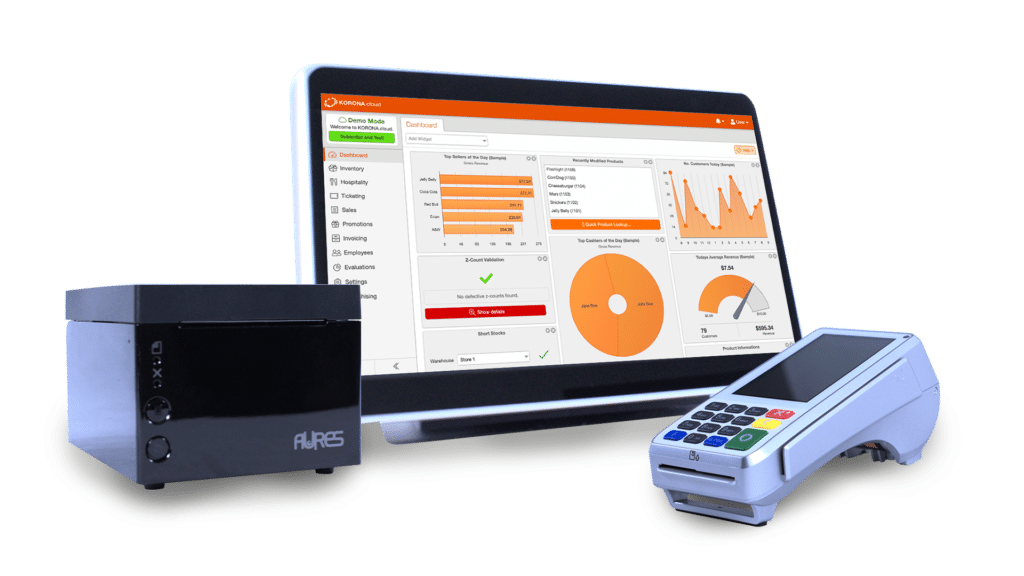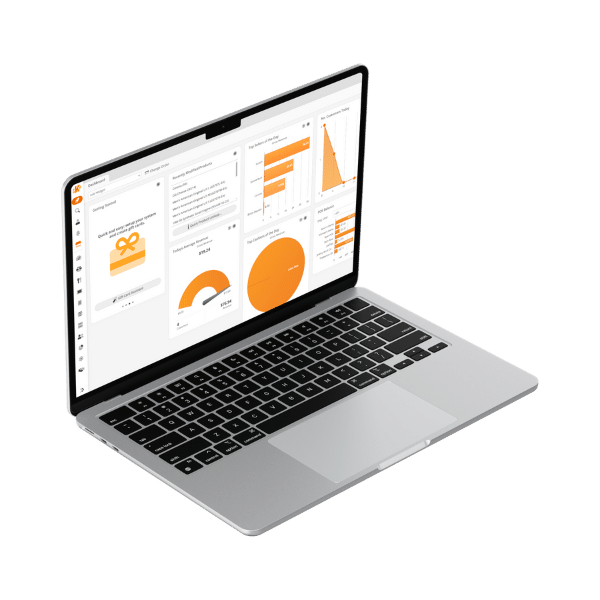? Key Takeaways:
- With smart inventory choices and strategic pricing, convenience stores can generate strong margins and steady revenue.
- Knowing how much you need to pay at the start and on a regular basis is important for success, whether you choose a low-cost or a high-end option.
- Success hinges on location, operations, staff training, and using tools like KORONA POS data and loyalty programs to stay ahead.
Thinking about how to open a convenience store? You’re in the right place. Starting a convenience store can be a smart and profitable business move—but only if you approach it with the right strategy.
Whether you’re just exploring the idea or ready to launch, this step-by-step guide will help you build a convenience store that runs smoothly and turns a steady profit.
How to Open and Manage a Successful Convenience Store
These seven steps will help you launch and run a profitable c-store.
Step 1: Create a Detailed Business Plan
Start with a business plan that outlines your product mix, pricing, foot traffic, competitors, and ideal customers. Include startup and operating costs, and create a financial forecast to secure funding from banks or alternative lenders.
? Pro Tip:
Create customer personas to refine your pricing, inventory, and marketing strategies for a tailored, competitive approach.
Step 2: Pick a Good Location for Your C-Store
Location can make or break your convenience store. Measure foot traffic manually, ask the current owner, or use cell phone data.
Additionally, you should avoid areas crowded with competitors or hidden spots. Instead, choose visible, high-traffic zones like near schools or offices, with easy access and parking to attract regular, loyal customers.
? Pro Tip:
Don’t just measure foot traffic—observe it. Watch customer patterns during peak hours to better predict high-demand times.
Step 3: Get the Right Licenses Before You Open Your Convenience Store
Before opening a convenience store, you’ll need several licenses and permits, such as an Employee Identification Number (EIN), an alcohol and tobacco license, a health permit, etc.
Securing these can be time-consuming, especially in busy areas, so start early. Being in compliance means your store will operate legally and avoid delays, fines, or issues down the road.
? Pro Tip:
Start the licensing process early, especially for permits that can take months.
Step 4: Focus on financial management
Take control of your finances early. Track each product’s sales and profit margin to improve pricing and purchasing decisions. Watch for shrinkage, which may signal theft, and monitor cash flow closely.
Reduce costs by negotiating with suppliers and streamlining inventory. Remember—convenience store profits rely on high volume and low margin.
? Pro Tip:
Track profit margins in real-time so you can tweak prices instantly and supercharge your store’s profits.
Step 5: Invest in Sound POS Technology and Security Systems

A reliable POS system for convenience stores is crucial for managing your finances and inventory. A cloud-based system like KORONA POS allows remote access to data and reports, offering flexibility. It tracks sales, vendors, inventory, and profits while preventing fraud.
Invest in surveillance cameras, alarms, and cashier monitors for added security to prevent loss.
? Pro Tip:
Choose a POS system with integrated analytics features that let you track sales trends and inventory in real time (hint: KORONA POS).
Get started with KORONA POS today!
Explore all the features that KORONA POS has to offer with an unlimited trial. And there’s no commitment or credit card required.
Step 6: Get to Know the Customers of Your Convenience Store
You should consider whether your customers are locals and tailor the store experience to them—create a welcoming atmosphere, offer convenient lunch counters, and ensure fast service. Whatever you do, focus on retail customer engagement and loyalty programs, especially for your regulars.
? Pro Tip:
Turn regular customers into loyal ambassadors by offering personalized deals and rewards for repeat visits.
Step 7: Decide Which Products You Want to Sell in Your C-Store
Convenience stores typically stock essentials like fresh produce, dairy, snacks, alcohol, tobacco, and household goods. You’ll also find fast food, takeaway coffee, sandwiches, desserts, cakes, and baked goods.
Additional items include newspapers, magazines, tea, coffee, pet food, and toiletries. The key is offering variety in a small space.
? Pro Tip:
Keep your store fresh with seasonal items!
Common Startup Costs for a Convenience Store
Here’s a breakdown of what you’ll spend to get your convenience store up and running:
Category | Low Budget | Mid-Range | High-End |
Startup Costs | $50K | $250k | $1M |
Inventory | $10K | $50K | $200K |
Equipment | $5K | $30K | $100K |
Licenses | $2K | $5K | $15K |
Renovation | $5K | $30K | $150K |
Security | $2K | $5K | $30K |
Recurring Monthly Costs
- Rent: $1K – $10K
- Payroll: $3K – $15K
- Gas/Products: $5K – $20K
⚠️ Remember:
Some expenses will vary based on location and store size!
Is Owning a Convenience Store Profitable?
Owning a convenience store can be profitable, but success depends on management, location, and inventory choices. Here’s how you can boost your store’s profitability.
Factor #1: Product Margins
Convenience stores typically enjoy higher margins (10-20%) compared to grocery stores, especially on high-demand items like tobacco, alcohol, and gas. Margins vary by category, so prioritize high-margin items in key store areas.
? Margin Breakdown by Product Category:
- Tobacco & Alcohol: 30-50%
- Snacks & Beverages: 20-40%
- Dairy & Household Items: 5-15%
Factor #2: Location & Traffic
The profitability of your store is strongly tied to its location. High foot or car traffic areas, like near schools, offices, or busy intersections, typically generate better sales. Urban and gas-attached stores have different cost structures but can benefit from higher volume sales, leading to increased profitability.
? Average Revenue vs. Top Performers:
- Average Store: $300,000–$500,000/year
- Top Performers: $1M+/year
Factor #3: Operating Costs and Management
Effective cost management is crucial for profitability. Fixed costs such as rent, payroll, and utilities must be carefully monitored. Keep inventory lean and negotiate better prices with suppliers to maintain healthy margins. Automate when possible and improve cash flow by minimizing waste and theft.
✔️ profit booster checklist:
✅ Implement loyalty programs to retain customers.
✅ Use impulse racks to promote last-minute purchases.
✅ Negotiate with vendors to reduce product costs.
✅ Monitor shrinkage to prevent inventory loss.
Different Business Models for Convenience Stores
When starting a convenience store, you have three main paths: buying an independent store, franchising, or building from scratch. Each model offers different benefits and challenges depending on your budget, goals, and experience.
Independent Stores
Owning an independent convenience store allows for complete control over branding and operations. This path offers flexibility but requires more time and effort to build a loyal customer base and manage all aspects of the business.
Pros | Cons |
Full control over pricing, inventory, and store design | Greater risk without brand recognition |
More profit potential without franchise fees | High startup costs and effort in building a customer base |
Freedom to implement unique marketing strategies | Limited support compared to franchises |
Franchise Stores
Franchise stores, like 7-Eleven or Shell, offer a proven business model with brand recognition. You benefit from a pre-established customer base and corporate support, but you’ll also pay royalties and adhere to strict brand guidelines.
Pros | Cons |
Established brand recognition and customer loyalty | Franchise fees and royalties reduce profits |
Ongoing corporate support (training, marketing, etc.) | Limited control over store design and operations |
Easier financing options due to established reputation | Ongoing obligations to the franchisor |
Starting from Scratch
Building a convenience store from scratch means complete freedom in designing your brand and business model. This path allows you to create something unique but comes with greater risk and higher initial costs.
Pros | Cons |
Complete creative control over store concept and operations | High startup costs with no initial customer base |
No ongoing franchise fees or royalties | Requires significant business management experience |
Potential for a unique niche market | Increased risk without a proven model for support |
By considering these three options and drawing inspiration from success stories, you can choose the best business model for your needs.
Financing Options to Start a Convenience Store
Launching a c-store can cost anywhere from $50,000 to over $1 million—so funding matters. Luckily, there are multiple ways to secure capital, from SBA loans to crowdfunding.
Below is a quick comparison of popular financing options to help you pick the right path for your business.
Financing Option | Pros | Cons | Avg. Interest Rate | Approval Time |
SBA Loan | Low interest, long terms, partially government-backed | Strict qualifications, long approval process | 6%–9% | 30–90 days |
Merchant Cash Advance | Fast access, based on sales not credit score | High cost, daily repayments | 20%–40% | 1–7 days |
Seller Financing | Negotiable terms, easier if buying existing store | May require large down payment | Varies (negotiated) | 7–30 days |
Crowdfunding | No repayment if rewards-based | Time-intensive, success not guaranteed | None (if rewards-based) | Varies (30–90 days) |
Conventional Loan | Competitive rates, predictable terms | Harder for startups, requires strong credit history | 7%–12% | 15–60 days |
? Pro Tip:
Use this SBA loan calculator to estimate monthly payments and get pre-qualified.
How To Run A Successful Convenience Store
Success in the c-store business depends on daily execution. From staffing to maintaining clean facilities, every detail affects your bottom line. Using convenience store inventory management software helps you stay on top of stock levels and meet customer demand consistently—building a store customers trust and return to.
? Track Your Inventory and Offer More Items
Use real-time inventory management systems to monitor bestsellers and ditch slow movers. Add seasonal items, bundle deals, and impulse buys to boost profits and keep customers curious.
? Make the Checkout Simple
Speed and convenience are your biggest assets. Streamline checkout with tap-to-pay, mobile wallets, or self-checkout so your customers are out the door in seconds. KORONA POS makes all of the above possible, and more.

Speak with a product specialist to learn exactly what you need and how we can help.
? Keep Your Bathrooms Neat
A clean, stocked restroom shows you care. It improves customer satisfaction and can even influence repeat visits—yes, it’s that important.
? Increase the Visibility Inside for Your Cashiers
Design your layout so staff can see the entire store from the register. This helps prevent theft, improves safety, and allows employees to assist customers quickly.
?♂️ Train and Motivate Your Staff
Friendly, well-trained employees create memorable customer experiences. Offer service training, reward upselling, and use flexible scheduling tools to reduce turnover and boost morale.
? Pro Tip:
Tools like Homebase or Deputy make shift scheduling a breeze and improve staff satisfaction.
? Use Promotions and Loyalty Programs to Boost Sales
Promos like “Buy 2, Get 1 Free” or “$1 coffee before 10 am” attract repeat traffic. A punch card or digital loyalty program can turn occasional visitors into regulars—driving higher basket sizes with every visit.
? Analyze Sales Data to Optimize Product Placement
Use POS data to see what sells fast and where. Place top-selling or high-margin items at eye-level or near checkout. A/B test layouts—moving snacks or drinks around—to spark more impulse buys.
Real-Life Success Story
Efficient tech, smooth checkouts, and reliable inventory tools can make a major difference—just ask Jason.
KORONA POS has made running our convenience store easy. The inventory tracking makes doing inventory simple, and the quick checkout process keeps our lines moving fast. It’s been a huge help during our busiest hours!
–Jason D., Shelby’s Quick Mart
Is Opening a Convenience Store Worth It?
So—is opening a convenience store worth it? Absolutely, if you approach it with the right strategy, tools, and mindset. With solid margins, community demand, and scalable options, convenience stores remain a smart business move.
And that’s where KORONA POS comes in. Our convenience store pos system has so many of the tools you need to run a successful convenience store, from real-time inventory management to employee management tools.













